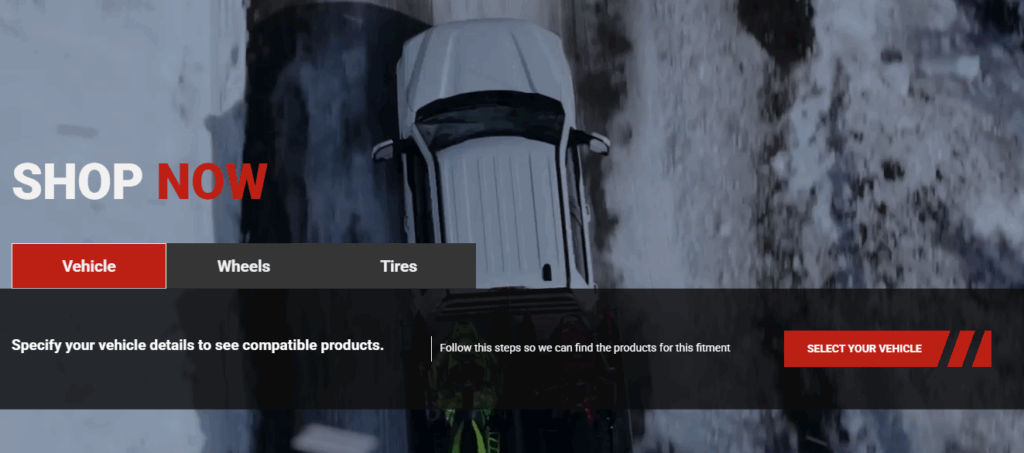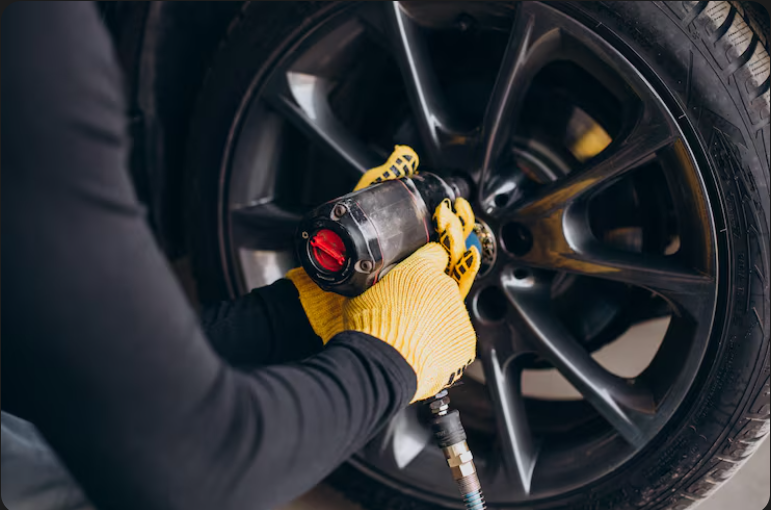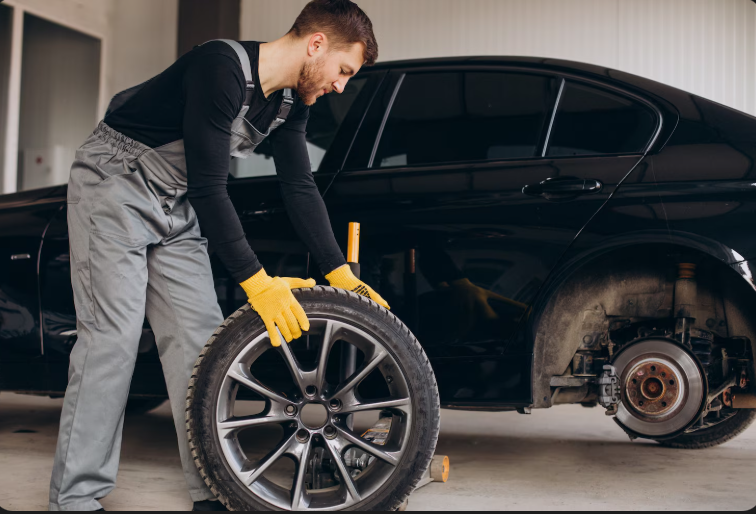As the first snow clouds gather and temperatures begin to dip below zero, Canadian drivers face one of the most demanding road seasons of the year. Each winter, icy streets and freezing temperatures contribute to thousands of collisions nationwide, many of which are directly linked to tire failure or poor traction.
According to Transport Canada, more than 30% of winter driving accidents involve vehicles with worn or under-inflated tires. Studies from the Tire and Rubber Association of Canada (TRAC) reveal that one in three drivers delays switching or checking their tires until after the first major snowfall, significantly increasing the risk of skidding or blowouts during early cold snaps.
Cold weather doesn’t just make the roads slippery - it also weakens tire rubber. When temperatures drop below 7°C, standard all-season tires begin to harden, reducing grip by up to 40% on wet or icy surfaces. Even small cracks or embedded debris that go unnoticed in autumn can become serious hazards once the mercury plummets.
That’s why performing a comprehensive tire inspection before the snow falls is essential for safety, performance, and peace of mind. At Canada Custom Autoworks, our experts recommend checking for damage, tread wear, and air pressure well before winter sets in, giving you time to repair, replace, or rotate your tires before the first freeze hits.
 In this guide, we’ll show you how to spot signs of tire damage early, test tread depth using the Canadian toonie test, and know when it’s time to visit your nearest Canada Custom Autoworks location for a professional inspection.
In this guide, we’ll show you how to spot signs of tire damage early, test tread depth using the Canadian toonie test, and know when it’s time to visit your nearest Canada Custom Autoworks location for a professional inspection.
The Hidden Dangers of Driving on Damaged Tires
Winter driving in Canada demands maximum tire performance, yet many drivers underestimate how quickly cold weather can turn minor tire issues into major safety risks. Even a small bulge, crack, or slow leak can have serious consequences once temperatures plunge below freezing.
When the temperature drops, air pressure decreases by roughly 1 PSI for every 5°C, reducing stability and traction. Under-inflated or damaged tires can’t maintain proper road contact, which leads to longer braking distances, less responsive steering, and a higher risk of hydroplaning or sliding on icy roads.
Research from the Canadian Automobile Association (CAA) shows that vehicles with compromised tires are three times more likely to lose control on snow or ice, even at low speeds. Cracks in the sidewall or worn tread not only reduce grip but also make tires more prone to sudden blowouts, a danger that increases when tires are cold and rigid.
“A small imperfection that goes unnoticed in October can become a serious hazard by December,” says a Canada Custom Autoworks tire technician. “Cold weather hardens the rubber and magnifies existing weaknesses, especially on highways where friction and temperature shifts are extreme.”
Beyond the immediate risk of accidents, driving on damaged tires accelerates uneven wear, affects fuel efficiency, and can even harm your vehicle’s suspension and alignment systems. By the time you feel vibration through the steering wheel or hear unusual noise, the damage is often far advanced.
This makes early inspection and maintenance before the snow hits one of the simplest and most effective ways to protect both your vehicle and your safety.
How to Inspect Your Tires Before the First Snow?
A quick, methodical check now can save you from mid-winter headaches later. Use the table below as your pre-snow tire inspection checklistь - it explains what to do, why it matters in Canadian winter, and what to do next if you spot a problem.
| Step | What to Do | Why It Matters (Winter) | Red Flags & Action |
| 1) Sidewall inspection (outer & inner) | Turn the wheel outward and inspect the outer sidewall; use a flashlight to check the inner sidewall, too. Look for cuts, cracks, bulges, and blisters. | Cold temps harden rubber; sidewall flaws can tear or blow out under highway loads or after hitting winter potholes. | Bulge/blister, deep crack, exposed cords → Replace tire immediately. Minor surface weathering → monitor and recheck in 2–3 weeks. |
| 2) Tread depth (Toonie test) | Insert a toonie into the tread, bear’s head first. | Deeper tread evacuates slush/snow and improves braking/steering on ice. | Tread at bear’s claws = good; silver rim visible = plan replacement; letters visible or wear bars flush = replace now. |
| 3) Tread wear indicators | Look across grooves for raised wear bars; if they’re level with the surrounding tread, the tire is worn. | Worn tread dramatically increases stopping distance and risk of snow planing. | Bars flush → Replace. Uneven approach to bars → see Step 5 (alignment/pressure). |
| 4) Embedded debris & punctures | Scan the tread for nails, screws, glass, and stones. Do a slow roll of the car to inspect the full circumference. | Small punctures become slow leaks; pressure drops faster in cold, reducing grip and control. | Remove small stones; if a metal object is embedded or hissing is heard → professional repair (plug/patch) or replace. |
| 5) Uneven wear pattern | Compare inner, center, and outer shoulders. Look for cupping, feathering, or one-sided wear. | Signals alignment, suspension, or inflation issues that worsen on icy roads and cause pulling or vibration. | One-sided wear/cupping → Alignment & suspension inspection. Center wear = overinflation; edge wear = underinflation. |
| 6) Air pressure (cold check) | Measure PSI cold (car parked ≥3 hours). Set to the door-jamb spec. Recheck weekly in winter. | Pressure drops with temperature; low PSI reduces contact patch and stability. | ≥3–5 PSI low consistently → inspect for leaks (Step 7). Do not exceed wheel/tire max PSI. |
| 7) Leak check (soap test) | Mix dish soap + water; brush on tread, sidewall, and valve. Watch for steady bubbles. | Finds slow leaks at punctures, bead, or valve—problems that get worse in freezing temps. | Bubbling at tread/sidewall → repair/replace. Bubbling at valve core → replace valve core; at valve stem/bead → shop service. |
| 8) Valve stems & caps | Wiggle stems gently; ensure caps are present and snug. | Caps protect the valve core from salt and slush; damaged stems leak more in the cold. | Cracked stem/missing caps → replace stem/caps. |
| 9) TPMS status (if equipped) | Start the car; check for TPMS warning. If on, verify PSI with a gauge (don’t rely solely on the light). | TPMS can lag in cold starts; confirming with a gauge prevents false confidence. | Light stays on after setting PSI → inspect for leaks or sensor issues. |
| 10) Age & condition check | Find the DOT date code (last 4 digits = week/year). Inspect for hardening, micro-cracks between tread blocks. | Rubber ages and stiffens; below ~7°C, older compounds lose flexibility and grip faster. | 6–10 years old, visible cracking, or hardened feel → replace, even with decent tread. |
| 11) Wheel & bead area | Look for rim bends, corrosion, or curb rash where the tire meets the wheel. | Corroded beads and bent rims cause slow leaks and winter air loss. | Bent rim/corrosion at bead → wheel repair and bead cleanup during remount. |
| 12) Spare tire readiness | Check tread, PSI, sidewall, and tools (jack, key for locking lugs). | A useless spare in winter can leave you stranded in sub-zero conditions. | Low PSI/damage → inflate/replace spare; verify tool kit is complete. |
| 13) Rotation/balance status | If vibrations or audible hum increase with speed, note mileage since last rotation/balance. | Unbalanced or unrotated tires cup quickly on cold, rough roads, reducing contact on ice. | >8–10k km since rotation or new vibration → schedule rotation/balance. |
| 14) Final road-feel check | On a short drive, note pulling, vibration, ABS activation in gentle braking, or traction control engaging too easily. | Early signs of grip or geometry issues are amplified on black ice and packed snow. | Any persistent symptom → professional inspection (alignment, balance, tire/ wheel check). |
Pro tip: Do this inspection in daylight with a flashlight and gloves. Photograph any questionable areas so a technician can assess them quickly.
Signs It’s Time to Repair or Replace Before Winter
Even with regular inspections, there comes a point when your tires are no longer safe for Canadian winter conditions. Cold weather, salt, and rough roads put enormous strain on rubber and tread, and once damage sets in, performance and safety drop quickly. Here’s how to know when it’s time to take action before the snow arrives.
1. Visible Cracks, Bulges, or Exposed Fabric
If you spot any cracks across the tread or bulges on the sidewall, it’s a clear sign the tire structure is compromised. These weak spots can burst suddenly when temperatures fluctuate or when driving over icy potholes. If fabric or cords are visible, the tire has reached a critical point and must be replaced immediately.
2. Persistent Low Air Pressure
If you find yourself refilling a tire more than once every couple of weeks, there’s likely a slow leak or damaged valve stem. In freezing conditions, air loss accelerates, and under-inflation makes steering sluggish while increasing the risk of tire separation. Schedule a professional inspection to locate and seal the leak or replace the tire if necessary.
3. Uneven or Excessive Tread Wear
Uneven wear, one side more worn than the other, or a scalloped pattern, points to alignment or suspension problems. Driving on uneven tires during winter reduces traction and braking power, especially on ice or packed snow. It’s best to rotate or replace the affected tires and get a wheel alignment before the first freeze.
4. Tires Older Than Six Years
Even with good tread, tires deteriorate over time. The rubber stiffens, losing the flexibility needed for proper grip. In Canada’s extreme cold, old tires can feel like plastic, offering little traction on ice or snow. Check the DOT code on the sidewall; if it’s more than six years old, consider replacement before the snow hits.
5. Vibrations or Unusual Noises While Driving
If your steering wheel shakes or you hear a rhythmic thumping sound, it may mean internal tire damage or imbalance. These symptoms often worsen as temperatures fall and rubber hardens. Continuing to drive under these conditions risks total tire failure — especially at highway speeds.
“A winter-ready tire isn’t just about tread depth - it’s about structural health,” explains a Canada Custom Autoworks technician. “If you’re unsure about a tire’s condition, replacing it before winter is far cheaper and safer than risking a blowout during a snowstorm.”
6. Consistent Warning Lights
If your Tire Pressure Monitoring System (TPMS) light keeps coming on even after adding air, it may indicate a slow leak or a damaged sensor. Never ignore a TPMS alert in winter — pressure drops faster in cold weather, and under-inflation drastically reduces traction.
Performing these checks in late fall gives you time to repair or replace tires before shops fill up for the busy winter season. Canada Custom Autoworks offers full tire inspections, balancing, and replacements to ensure every driver heads into winter with confidence and peace of mind.
 Why an Expert Tire Inspection Makes the Difference?
Why an Expert Tire Inspection Makes the Difference?
A driveway check catches the obvious, but many winter-risk issues hide beneath the surface. Professional inspections use calibrated tools and procedures that spot problems long before they become roadside emergencies.
What do our technicians check?
- Road-force balancing: Measures stiffness variation and out-of-round conditions that cause cold-weather vibration and patchy traction.
- Digital tread depth mapping: Finds uneven wear across inner/outer shoulders you can’t see from one angle.
- Bead & rim interface inspection: Detects slow leaks from corrosion or micro-gaps where the tire meets the wheel; we clean, seal, and remount.
- TPMS health & programming: Tests sensors, replaces valve cores/stems, and reprograms IDs after seasonal changeovers.
- Alignment diagnostics: Verifies camber, caster, and toe so your tires track straight on icy pavement and avoid rapid shoulder wear.
- Sidewall & carcass integrity checks: Identifies internal cord damage (from potholes/curbs) that looks fine outside but can fail in the cold.
- Compound & age assessment: Confirms rubber condition and advises when aging, not just tread depth, makes a tire winter-unsafe.
“Most mid-winter tire failures start as small fall problems. A 30-minute inspection now can save you hours on the shoulder in a snow squall.”
Repair and replacement done right for winter
- Patch-plug repairs for punctures in the repairable zone; non-repairable damage gets same-day replacement options.
- Winter tire fitting & torque: Mount, balance, and re-torque after initial heat cycles for safety.
- Rotation plans: Mileage-based rotation to keep traction even on all four corners through freeze–thaw cycles.
Convenience across Canada
From Calgary, Edmonton, and Fort Saskatchewan to Regina and Saskatoon, Canada Custom Autoworks offers quick booking, transparent estimates, and winter-ready turnarounds. Bring your notes or photos from your home inspection, and we’ll validate them and prioritize what truly matters for safety.
Ready for a professional check? Book a pre-winter tire inspection at your nearest Canada Custom Autoworks location and head into the first snowfall with confidence.

